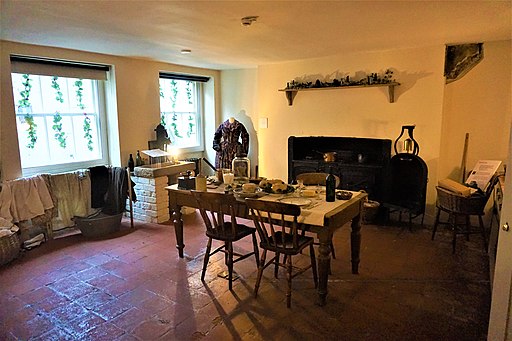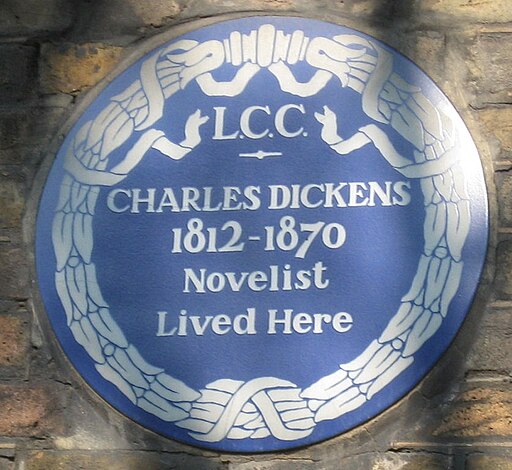
The Charles Dickens Museum is the author’s house turned into a museum about Charles Dickens. The museum is housed in a Georgian terraced house, which was Charles Dickens’s home from 1837 to 1839.
Charles Dickens and his wife Catherine Dickens, lived here, and their older two daughters, Mary and Kate, were born in this house.
Charles Dickens (1812 – 1870) was a famous and influential English writer and social critic. He created some of the world’s best-known fictional characters and is regarded as the most celebrated novelist of the Victorian era.
His works enjoyed popularity during his lifetime, and by the 20th-century scholars had recognized him as a literary genius. Despite his lack of formal education, he wrote 15 novels, five novellas, hundreds of short stories and non-fiction articles.
Dicken’s popularity was supported by lectures and performed readings. He was an untiring letter writer and campaigned vigorously for children’s rights, education, and other social reforms.
Charles Dickens Dining Room

The Dining Room is located on the ground floor of Charles Dicken home. Its ideal position in the house and grand architecture of the house was ideal for launching Dickens socially.
This elegant room played a vital role as the rising author enjoyed his first flush of success. Dickens entertained many leading and influential Victorian figures in this room.

In 1836, after a one-year engagement, Dickens married Catherine Thomson Hogarth (1816–1879), the daughter of George Hogarth, editor of the Evening Chronicle.
The family set up home in Bloomsbury in this house, on which Dickens had a three-year lease at £80 a year, from 1837 – 1839.
Charles Dickens Morning Room

Catherine Dickens used this room to manage domestic and household matters. Mrs. Dickens spent time with her children, wrote letters, and welcomed visitors to this room.
Dickens spent much of his time traveling away from home, and they kept in touch with regular written correspondence. Many of their surviving letters demonstrate that their time in this house was a particularly happy time for the Dickens couple.

One year before they moved into this house, after a one-year engagement, in 1836, Dickens married Catherine Thomson Hogarth (1816–1879).
The family set up home in Bloomsbury in this house, on which Dickens had a three-year lease at £80 a year, from 1837 – 1839.
Charles Dickens Kitchen

The Kitchen is located on the basement level, and this is where the servants prepared the family meals.
The kitchen was managed by the mistress of the house, Catherine Dickens, as traders and merchants came in and out with food supplies.
Victorian kitchens of the time were low-lit and filled with heat and smoke from the cooking fires.

In 1836, after a one-year engagement, Dickens married Catherine Thomson Hogarth (1816–1879).
The family set up home in Bloomsbury in this house, on which Dickens had a three-year lease at £80 a year, from 1837 – 1839.
These years were a happy period for the Dickens couple with two of their children born in this house.
Charles Dickens Washhouse

The washroom was used by the maids to wash and iron clothes for the household. This arrangement is a typical Victorian-era washhouse.
Dickens’s portrayal of servants was more sympathetic than most of his peers, and his views endeared him to the domestic staff around England at the time.

In 1836, after a one-year engagement, Dickens married Catherine Thomson Hogarth (1816–1879), the daughter of George Hogarth, editor of the Evening Chronicle.
The family set up home in Bloomsbury in this house, on which Dickens had a three-year lease at £80 a year, from 1837 – 1839.

This Blue Plaque is on the building located at 48 Doughty Street in Holborn, London. Which is also the location of the Charles Dickens Museum.
The museum is housed in a Georgian terraced house, which was Charles Dickens’s home from 1837 to 1839. Charles Dickens and his wife Catherine Dickens lived here, and the older two of Dickens’s daughters, Mary Dickens and Kate, were born in this house.
A blue plaque is a historical marker in the United Kingdom to commemorate a link between that location and a famous person or event.
The “official” scheme is administered by English Heritage and traces its origins to 1866 in London, on the initiative of the politician, to mark the homes and workplaces of famous people. It was the first such scheme in the world. It has provided the inspiration and model for many others across the globe.
The plaques erected are made in a variety of designs, shapes, materials, and colors: some are blue, others are not.
There are now many historical marker schemes throughout the world, such as those in leading cities in Europe, Australia, Canada, Russia, and the United States.
Charles Dickens Museum
- Name: Charles Dickens Museum
- City: London
- Country: United Kingdom
- Opened: 1925
- Location: 48 Doughty Street in Holborn, London
Facts about Charles Dickens
- Originally the word “Dickens” was a curse. Instead of saying, “What the devil?” as a profanity, people exclaimed, “What the dickens?” The first written usage of that word was William Shakespeare’s The Merry Wives of Windsor.
- His father, the elder Dickens, amassed so much debt that the entire family, except for Charles and his older sister Fanny, were sent to debtors’ prison. At 12 years old, Charles Dickens had to drop out of school and work at a Blacking Warehouse along the River Thames. He earned six shillings a week pasting labels onto blacking pots used for shoe polish.
- As a child, Dickens had epilepsy, and he was also thought to have had obsessive-compulsive disorder.
- Dickens’s first published works, which appeared in a Monthly Magazine in 1833 and 1834, were under the pseudonym of “Boz.”
- Dickens was a member of “The Ghost Club,” a group in London dedicated to investigating the paranormal. “The Ghost Club” is the oldest ghost-hunting organization in London and included Sir Arthur Conan Doyle, the author of Sherlock Holmes.
- Dickens had an interest in hypnosis and learned how to hypnotize others. He practiced on his wife, children, and friends.
- Dickens married Catherine Hogarth in 1836, and together they had ten children. Dickens and his wife separated in 1858 due to his relationship with young actress Ellen Ternan.
- Dickens wished to be buried in a simple grave in the cemetery of Rochester Cathedral in Kent. But when he died in 1870, he was buried in Poets’ the Corner of Westminster Abbey.
- Dickens stipulated in his will that “no public announcement be made of the time or place of my burial.” However, his fame was such that hundreds of thousands of people lined up to walk past his body in Westminster Abbey.
Charles Dickens
Charles John Huffam Dickens (1812 – 1870) was an English writer who created some of the world’s best-known fictional characters and one of the most celebrated novelists of the Victorian era.
His works enjoyed unprecedented popularity during his lifetime, and his novels and short stories are still widely read today.
- Name: Charles John Huffam Dickens
- Born: 1812 – Landport, Hampshire, England
- Died: 1870 (aged 58) – Higham, Kent, England
- Buried: Poets’ Corner, Westminster Abbey
- Nationality: British
- Notable works :
- The Pickwick Papers
- Oliver Twist
- Nicholas Nickleby
- A Christmas Carol
- David Copperfield
- Bleak House
- Little Dorrit
- A Tale of Two Cities
- Great Expectations
~~~
“There are dark shadows on the earth, but its lights are stronger in the contrast.”
~~~
“Charity begins at home, and justice begins next door.”
~~~
“I never could have done what I have done without the habits of punctuality, order, and diligence, without the determination to concentrate on one subject at a time.”
~~~
“There is nothing in the world, so irresistibly contagious as laughter and good humor.” – A Christmas Carol
~~~
“No one is useless in this world who lightens the burdens of another.”
~~~
“Procrastination is the thief of time, collar him.” – David Copperfield
~~~
“Ask no questions, and you’ll be told no lies.” – Great Expectations
~~~
“There is prodigious strength in sorrow and despair.” – A Tale of Two Cities
~~~
“The most important thing in life is to stop saying ‘I wish’ and start saying ‘I will.’ Consider nothing impossible, then treat possibilities as probabilities.”
~~~
“It was the best of times, it was the worst of times.” – A Tale of Two Cities
~~~
Explore London’s Museums and Heritage Sites
- The British Museum
- The National Gallery, London
- Tate Britain
- The Wallace Collection
- The Victoria and Albert Museum
- Queen’s Gallery, Buckingham Palace
- Courtauld Gallery
- Tate Modern, London
- Science Museum, London
- National Portrait Gallery, London
- Natural History Museum
- Charles Dickens Museum
- Hampton Court Palace
- Sherlock Holmes Museum
- British Library
- Imperial War Museum
- Churchill War Rooms
- Florence Nightingale Museum
- Foundling Museum
- Grant Museum of Zoology and Comparative Anatomy
- Cutty Sark, Royal Museums Greenwich
- National Maritime Museum, Greenwich
- Old Royal Naval College, Greenwich
- Queen’s House, Greenwich
- Royal Observatory, Greenwich
- Guildhall Art Gallery
- HMS Belfast
- Jewel Tower
- Jewish Museum London
- Bank of England Museum
- London Transport Museum
- Museum of London
- Museum of London Docklands
- National Army Museum, London
- Petrie Museum of Egyptian Archaeology
- Royal Air Force Museum London
- Sir John Soane’s Museum
- St Paul’s Cathedral
- City of London Police Museum
- Household Cavalry Museum
- Museum of Freemasonry
- Tower Bridge, London
- Tower of London
- Shakespeare’s Globe
Explore Famous Quotes
- Quotes about Art
- Quotes About History
- Quotes about Libraries
- Quotes about Museums
- Quotes about War
- Napoleon Quotes
- Leonardo da Vinci Quotes
- Charles Dickens Quotes
- Sherlock Holmes Quotes
- Leonardo da Vinci Quotes
- Proverbs and Quotes
Map for Charles Dickens Museum
About the Charles Dickens Museum, London
Charles Dickens Museum
Charles Dickens’s Grooming Kit, Charles Dickens Museum
~~~
“It was the best of times, it was the worst of times.”
– Charles Dickens
~~~
Photo Credit: JOM; Ijon [CC BY-SA 4.0 (https://creativecommons.org/licenses/by-sa/4.0)]
Popular this Week








 Sponsor your Favorite Page
Sponsor your Favorite Page SEARCH Search for: Search Follow UsJoin – The JOM Membership Program
Sponsor a Masterpiece with YOUR NAME CHOICE for $5
Share this:
- Tweet
